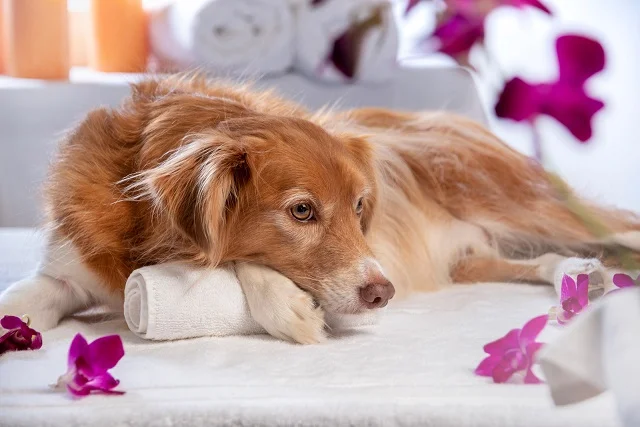
Aromatherapy, once considered a holistic practice primarily for humans, has gained significant popularity in the realm of pet care. This natural approach to promoting wellness in pets is based on the use of essential oils extracted from plants. Aromatherapy focuses on harnessing the therapeutic properties of these oils to support physical and emotional well-being in animals. This article aims to explore the benefits, safe choices, techniques, and recipes involved in incorporating aromatherapy into your pet’s wellness routine.
As pet owners increasingly seek out alternative methods for enhancing their furry friends’ health, aromatherapy has emerged as a promising option. Its gentle and non-invasive nature appeals to those who prefer a more natural approach to pet care. By using pet-friendly essential oils, derived from specific plants and carefully selected for their safety and effectiveness, you can provide soothing relief for common issues such as anxiety, stress, skin conditions, allergies, and even sleep problems.
The rise of aromatherapy for pets reflects an evolving understanding of our pets’ needs and desires. Aromatherapy creates a sensory experience that appeals to animals’ heightened sense of smell; scents have the power to evoke specific emotions and physiological responses in both humans and animals alike.
With proper knowledge and guidance, integrating aromatherapy into your pet’s wellness routine can strengthen the bond between you while improving their overall quality of life. In this article section, we will examine the various benefits that aromatherapy offers to pets and explore how this natural practice can contribute to their well-being.
Understanding Essential Oils
The Importance of Choosing Pet-Friendly Essential Oils
When it comes to using aromatherapy for pets, it is crucial to select essential oils that are safe and beneficial for their well-being. Not all essential oils are pet-friendly, as some can be toxic or cause adverse reactions in animals. Therefore, pet owners should exercise caution and do their research before introducing any essential oil to their furry friends.
It is recommended to consult with a veterinarian who is knowledgeable about aromatherapy for pets. They can advise on which essential oils are safe and suitable based on the specific needs of the animal. Additionally, pet owners should be wary of misinformation found online or from well-meaning individuals without proper expertise in veterinary aromatherapy.
A Comprehensive List of Essential Oils Safe for Pets
While there are many essential oils that should be avoided around pets, there are also several that can be used safely and offer benefits for their health and well-being. Here is a comprehensive list of some pet-friendly essential oils:
- Lavender: Known for its calming properties, lavender can help reduce anxiety and promote relaxation in pets.
- Roman Chamomile: This gentle oil is soothing and can assist with stress relief and skin irritations.
- Frankincense: Effective in boosting immunity and promoting overall wellness, frankincense can be beneficial for aging pets or those recovering from illness or surgery.
- Sweet Orange: Many pets enjoy the uplifting scent of sweet orange, which can help alleviate stress and provide an energizing boost.
It’s important to note that each animal may react differently to specific essential oils. Some pets may have allergies or sensitivities that make them more susceptible to adverse reactions. Therefore, it is crucial to start with small amounts and monitor your pet closely when first introducing any new oil.
Potential Dangers of Using Certain Essential Oils on Pets
While there are many essential oils that can be safely used around pets, there are some that should be avoided entirely. These include but are not limited to:
- Tea Tree: Tea tree oil is highly toxic to cats and can cause a range of adverse reactions, including tremors, difficulty walking, and even liver damage.
- Clove: Clove oil contains a compound called eugenol that can be toxic to cats and dogs when ingested or applied topically in high concentrations.
- Wintergreen: Wintergreen oil contains methyl salicylate, which can be toxic if ingested or come into contact with the skin of pets.
Always exercise caution and thoroughly research any essential oil before using it on or around your pet. When in doubt, consult with a veterinarian who specializes in aromatherapy for pets to ensure the safety and well-being of your furry companion.
Aromatherapy Techniques for Different Pet Needs
Aromatherapy has gained popularity in the pet care industry due to its natural and holistic approach to promoting pet wellness. Different pets have varying needs, and aromatherapy can be tailored to address these specific concerns. Here are some essential techniques for different pet needs:
- Aromatherapy for Relaxation and Stress Relief in Anxious Pets: Just like humans, pets can experience anxiety and stress. Aromatherapy can help calm their nerves and create a relaxing environment. Lavender essential oil is well-known for its soothing properties and is safe for most pets. Create a peaceful atmosphere by using a diffuser or making a lavender-infused spray.
- Aromatherapy for Boosting Immunity and Overall Well-being: Essential oils such as eucalyptus, tea tree, and lemon have antimicrobial properties that can support a pet’s immune system. These oils may be used sparingly on pets or diffused into the air to disinfect the surroundings. It’s important to consult with a veterinarian before using these oils, as some animals may be more sensitive to them.
- Aromatherapy for Promoting Better Sleep in Pets: Just like humans, pets also benefit from a good night’s sleep. Chamomile essential oil is known for its calming properties and can promote better sleep in pets. Create a bedtime routine by using chamomile oil in a diffuser or adding diluted oil to their beddings.
- Aromatherapy for Soothing Skin Conditions and Allergies: Pets suffering from skin conditions or allergies can find relief through aromatherapy. Oils such as chamomile, helichrysum, and lavender possess anti-inflammatory properties that can help soothe itchy skin or hot spots. Dilute these oils according to the guidelines provided by your veterinarian before applying them topically.
To effectively utilize aromatherapy for different pet needs, it is important to introduce the scents gradually and observe your pet’s reaction. Start with low concentrations and monitor any signs of discomfort or adverse reactions. Additionally, always be aware of the specific needs and sensitivities of your pet when choosing essential oils to ensure their safety.
Ultimately, aromatherapy can complement traditional veterinary care to provide a holistic approach to pet health and well-being. By incorporating these techniques into your pet’s routine, you can promote relaxation, improve immunity, support better sleep, and alleviate skin conditions or allergies.
Introducing Aromatherapy to Your Pet
Introducing aromatherapy to your pet can be a beneficial addition to their wellness routine. However, it is important to approach this practice with caution and care. Here is a step-by-step guide on how to introduce aromatherapy to your pet safely:
- Consult with your veterinarian: Before starting any new therapy or using essential oils on your pet, it is crucial to consult with your veterinarian. They will be able to provide guidance based on your pet’s individual health needs and any potential contraindications.
- Select the right essential oils: Not all essential oils are safe for pets. It is essential to choose pet-friendly oils that are known to be safe and beneficial. Some good options include lavender, chamomile, frankincense, and cedarwood. Avoid oils such as tea tree, citrus oils, and peppermint, as they can be toxic or irritating for pets.
- Properly dilute the essential oils: Essential oils are highly concentrated, so it is important to dilute them before using them on your pet. Dilute the essential oil with a carrier oil such as coconut oil or jojoba oil at a ratio of 1-3 drops of essential oil per teaspoon of carrier oil.
- Test for sensitivity: Before applying the diluted essential oil onto your pet’s skin or fur, perform a patch test first. Apply a small amount of the diluted mixture on a small area of their skin and observe for any adverse reactions like redness or irritation.
- Choose the right application method: There are several ways you can administer aromatherapy to your pet. For topical application, you can apply the diluted mixture onto their fur or paws (avoiding their eyes, nose, and mouth). Another option is using a diffuser in their environment to create an aromatic atmosphere. You can also use a spray by diluting the essential oil mixture with water and misting it in their surroundings.
Remember, every pet is unique, and their response to aromatherapy may vary. Always observe your pet’s behavior and discontinue use if you notice any signs of discomfort or adverse reactions. With proper care and consultation, aromatherapy can be a wonderful addition to your pet’s wellness routine.
DIY Aromatherapy Recipes for Pets
Introduction to DIY Aromatherapy Recipes for Pets
One of the greatest advantages of incorporating aromatherapy into your pet’s wellness routine is the ability to create custom blends and recipes specifically tailored for their needs. DIY aromatherapy recipes allow pet owners to have complete control over the ingredients used and can be a cost-effective alternative to store-bought products. In this section, we will explore some easy and safe DIY aromatherapy recipes for pets that can enhance their emotional well-being and address common health issues.
Homemade Pet-Friendly Sprays
One popular DIY aromatherapy recipe for pets is the creation of homemade pet-friendly sprays. These sprays can be used in various ways, such as freshening up their bedding or creating a calming atmosphere in their living space. To make a simple pet-friendly spray, start with a base of distilled water or hydrosol, which is the floral water byproduct of essential oil distillation.
Add a few drops of pet-safe essential oils such as lavender or chamomile, known for their relaxing properties. Shake well before each use and mist around your pet, being careful to avoid contact with their eyes or sensitive areas.
Aromatherapy Diffuser Blends
Another way to incorporate aromatherapy into your pet’s daily routine is by using diffuser blends. Diffusers disperse essential oils into the air, allowing your pets to inhale the beneficial properties. When creating diffuser blends for pets, it’s important to choose oils that are safe and non-toxic.
A popular blend for relaxation could include lavender, cedarwood, and vetiver essential oils. For an energizing blend to promote focus and mental clarity, consider using peppermint and lemon essential oils. Keep in mind that pets have more sensitive noses than humans, so use fewer drops of essential oil compared to what you would typically use for yourself.
Pet-Friendly Massage Oils
Massage can be a wonderful way to bond with your pet while providing relaxation and comfort. Creating your own pet-friendly massage oil is a simple and effective way to incorporate aromatherapy into this practice. Start with a carrier oil such as coconut or sweet almond oil and add a few drops of pet-safe essential oils like frankincense or geranium.
These oils are known for their soothing properties and can help promote muscle relaxation and joint health. Before using the massage oil, perform a small patch test on your pet’s skin to ensure they do not have any adverse reactions.
By using these DIY aromatherapy recipes, you can take an active role in improving your pet’s overall well-being in a safe and natural way. However, it is important to remember that each pet is unique, and some may have sensitivities or allergies to certain ingredients. Always monitor your pets closely when introducing new scents or products, and consult with your veterinarian if you have any concerns about their safety or potential interactions with existing medications or conditions.
Case Studies
Aromatherapy has gained popularity as a natural and holistic approach to promoting the wellness of pets. Numerous success stories highlight the positive impact of aromatherapy on pets’ physical and emotional health. These case studies serve as inspiring examples of how aromatherapy can be beneficial for pets with various conditions and help improve their overall well-being.
One such success story involves a dog named Max, who suffered from severe anxiety during thunderstorms. Max would tremble, pant heavily, and hide under furniture whenever a storm approached. His owner researched potential solutions and decided to try aromatherapy using lavender essential oil.
By diffusing lavender oil in the room during storms and applying diluted lavender oil topically to Max’s collar, his anxiety significantly reduced. The calming effects of lavender helped relax Max during thunderstorms, allowing him to feel more secure and less anxious.
Another case study involves a cat named Luna, who had chronic skin allergies and experienced frequent itching and scratching. Traditional treatments provided temporary relief but did not address the root cause of her allergies. Luna’s owner turned to aromatherapy using chamomile essential oil due to its soothing properties for inflamed skin.
They diluted chamomile oil with a carrier oil and applied it topically to Luna’s irritated areas twice daily. Over time, Luna’s itching decreased, her skin healed, and she enjoyed significant relief from her allergies.
Success stories like these demonstrate that aromatherapy can be an effective complementary therapy for pets facing various health challenges. It is important to note that each pet is unique, so what works for one may not work for another. Consulting with a veterinarian before introducing aromatherapy is crucial to ensure it is safe and appropriate for your pet’s specific needs.
| Case Study | Pet Name | Condition | Treatment | Results |
|---|---|---|---|---|
| 1 | Max | Anxiety during thunderstorms | Lavender essential oil (diffused and topically applied) | Significant reduction in anxiety, increased calmness during storms |
| 2 | Luna | Chronic skin allergies and itching | Chamomile essential oil (topically applied) | Decreased itching, healing of irritated skin, relief from allergies |
Overall, the use of aromatherapy in these case studies showcases its potential to provide relief and improve the quality of life for pets. These success stories highlight the importance of understanding each pet’s specific needs and tailoring aromatherapy treatments accordingly. With proper research, guidance from a veterinarian, and careful experimentation, pet owners can harness the benefits of aromatherapy to support their furry friends’ well-being.
Precautions and Safety Measures in Aromatherapy for Pets
When it comes to using aromatherapy on pets, it is crucial to prioritize their safety and well-being. While aromatherapy can offer many benefits to pets, it is important to be aware of certain precautions and safety measures in order to prevent any adverse reactions or harm. Here are some essential guidelines for safely practicing aromatherapy with your beloved furry friends.
First and foremost, it is essential to consult with a veterinarian before incorporating aromatherapy into your pet’s wellness routine. This is especially important if your pet has any pre-existing health conditions or if you are unsure about the potential risks associated with certain essential oils. A veterinarian can provide guidance specific to your pet’s needs and help you make informed decisions regarding which oils are safe for use.
It is also important to highlight that not all essential oils are safe for pets. Certain oils can be toxic and pose a danger if absorbed or ingested by pets. For example, essential oils such as tea tree, citrus, peppermint, and eucalyptus can be harmful to cats due to their unique metabolism. That being said, always research and carefully choose pet-friendly essential oils that are safe for your specific type of pet.
| Pet-Safe Essential Oils (Dogs) | Benefits |
|---|---|
| Lavender | Calming, anti-anxiety, soothing insect bites |
| Chamomile | Gentle sedative, anti-inflammatory, skin soothing |
| Cedarwood | Repels insects, helps with skin conditions, calming |
| Frankincense | Relaxing, immune-boosting, cellular regeneration |
Remember to always follow proper dilution guidelines when using essential oils on pets. Unlike humans, pets are more sensitive to the potency of essential oils and can experience adverse reactions if not properly diluted. A general rule of thumb is to dilute essential oils in a carrier oil such as almond oil or coconut oil before applying them to your pet’s fur or skin.
Lastly, it is important to handle and store essential oils safely to prevent accidental exposure or ingestion by pets. Keep essential oils out of reach from curious paws and securely closed when not in use. If accidental exposure occurs, contact your veterinarian immediately for guidance.
By following these precautions and safety measures, you can enjoy the benefits of aromatherapy while ensuring the well-being of your furry friends. Always prioritize their health and consult with a professional when in doubt. Aromatherapy can be a wonderful addition to your pet’s wellness routine when practiced responsibly.
Conclusion
In conclusion, incorporating aromatherapy into your pet’s wellness routine can provide a natural and nurturing approach to their care. Throughout this article, we have explored the benefits and applications of aromatherapy for pets, as well as provided guidance on safe choices of essential oils and various techniques for different pet needs.
Aromatherapy offers a holistic approach to promoting pet wellness by addressing issues such as anxiety, immune support, sleep problems, skin conditions, and allergies. The use of pet-friendly essential oils can help calm anxious pets, boost their overall well-being, soothe skin irritations, and provide relief from joint pain. By incorporating aromatherapy into their daily routines, pet owners have found success in improving the quality of life for their beloved companions.
It is important to note that before beginning any aromatherapy regimen with your pet, it is crucial to consult with a veterinarian knowledgeable in essential oils. They can provide guidance on specific oils that are safe and appropriate for your pet’s individual needs. Additionally, understanding the potential risks and adverse reactions associated with certain essential oils is paramount to ensuring your pet’s safety.
Incorporating aromatherapy into your pet’s wellness routine can be an enjoyable and rewarding experience for both you and your furry friend. It allows for a deeper bond between you and your pet as you explore different scents together and observe the positive effects they have on their well-being. So why not give it a try?
Consider experimenting with some of the easy DIY recipes provided in this article or seek professional advice if needed. Embrace the power of aromatherapy as a natural means to promote health and happiness in your cherished companion’s life.
Frequently Asked Questions
Is aromatherapy safe for pets?
Aromatherapy can be safe for pets, but it’s crucial to exercise caution and consult with a veterinarian before using any essential oils or aromatherapy products. While some essential oils may offer benefits for certain conditions in pets, others can be harmful or even toxic. Pets, particularly cats and smaller animals, are more sensitive to essential oils due to their unique physiology.
Oils high in phenols, such as tea tree oil and cinnamon bark oil, should generally be avoided as they can cause adverse reactions. It’s essential to research thoroughly and choose pet-safe essential oils from reputable sources when considering aromatherapy for your furry friends.
Is it safe to use an essential oil diffuser around pets?
Using an essential oil diffuser around pets requires careful consideration of the specific oils being used and the pet’s individual sensitivity and health condition. While some essential oils may be safe to use around pets if properly diluted and controlled, others can pose risks when diffused into the air. Strong scents can overwhelm animals with acute senses of smell or respiratory problems.
Cats, in particular, lack certain liver enzymes necessary to metabolize certain compounds present in essential oils like limonene and linalool found in citrus oils and lavender respectively. Therefore, it is advisable to keep diffusers in well-ventilated areas away from pets’ direct access.
What essential oils are safe to use around pets?
Several essential oils are generally considered safe to use around pets when used appropriately and in moderation. Lavender oil is often considered safe for dogs when diluted properly under veterinary guidance, as it may help soothe anxious or stressed dogs. Chamomile oil is also known for its calming effects on both dogs and cats, promoting relaxation during stressful situations such as thunderstorms or vet visits when administered as recommended by professionals.
Additionally, peppermint oil is often used for repelling insects, fleas specifically; however, it must be highly diluted because concentrated forms can cause toxicity in pets if ingested or applied topically without proper dilution. Regardless, it is essential to consult a veterinarian before using any essential oil around pets, ensuring their safety and well-being.





